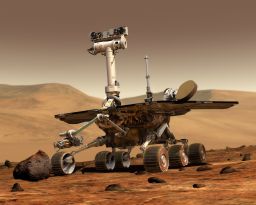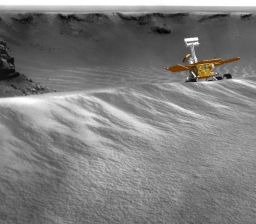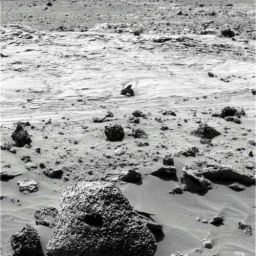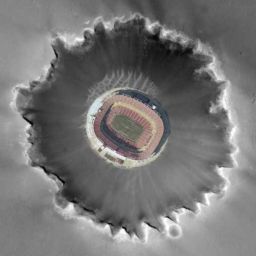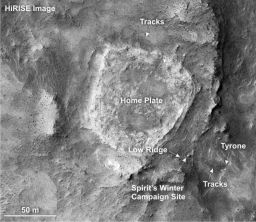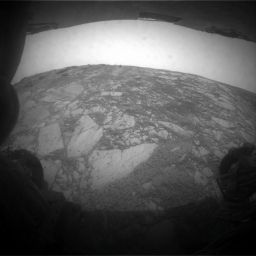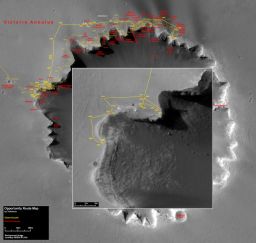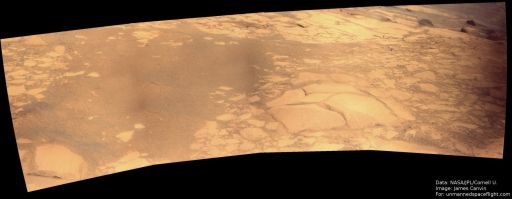A.J.S. Rayl • Sep 30, 2007
Mars Exploration Rovers Update: Spirit Slides Across Home Plate as Opportunity Digs in at Victoria Crater
It might not be the stuff of Broadway musicals, but the Sun and did "come out tomorrow" on Mars. Just eight weeks after dust from severe storms darkened the Martian skies and threatened their solar-powered lives, the Mars Exploration Rovers finished dusting off as much as possible and took off on their long-anticipated expeditions this month, with Spirit roving onto an old volcanic formation called Home Plate and Opportunity cruising into Victoria Crater.
Skies above both rovers remain dusty, but have been clearing steadily since early August and are now back close to what they were prior to the dust storms, more like a smoggy day as opposed to zero visibility. And, with every passing week, the Sun is appearing brighter and more defined in the panoramic camera (Pancam) pictures the rovers send home.
Although Jake Matijevic, chief engineer for the rovers at JPL, and Ray Arvidson, of Washington University St. Louis, deputy principal investigator for rover science, were confident as of late last month that the rovers had survived the dust storms, now, with the atmospheric density or tau levels getting "comfortably low" and the dissipation in atmospheric dust steadily continuing for several weeks, even Steve Squyres is ready to assume victory. "I'm finally willing to say that the rovers have survived the dust storm," said the principal investigator for the rover science from his MER operations center at Cornell University during an interview Friday. "I was actually reluctant to say that for the longest time, because I wasn't confident the dust wasn't going to kick up on us again."
"This was a rover-killing dust storm," underscored John Callas, MER project manager, at the Jet Propulsion Laboratory (JPL), where the rovers were designed and are being managed. "Spirit and Opportunity were never designed to survive dust storms or the kinds of atmospheric opacities they experienced this summer and the fact that they both survived is remarkable, especially since we had the complexity with Opportunity, which still has a heater stuck 'on' that was sucking power every day we did want to waste."
"It speaks to how much quality and how much margin was put in the design when we built these things, that they are still going strong after two Martian winters and a global dust storm," added Squyres. "It's been great to see the Sun again."
The way the MER team members see the Sun from Mars is, of course, through the rovers' eyes -- or Pancams -- which take pictures of the Sun every day to determine how opaque or dusty the sky is over Gusev Crater where Spirit is exploring Home Plate and Meridiani Planum, where Opportunity has descended into Victoria Crater. With the Sun commanding the images and the Martian skies once again, both rovers returned this month to full work schedules.
"It's a relief," Squyres said. "I was nervous, particularly about Opportunity, but I never had a feeling of despair and there was never a time when I thought we were going to lose one of them. I consistently felt our chances of making it through were good and the performance of the rovers bore that out. Mars is a life-threatening place. There have been plenty of life-threatening things that have happened to these vehicles, so I feel real good about this."
If Mars has showed its warring colors during the storms this summer, it has also, it seems, shown a kind of acceptance, if not affection, for the twin robot field geologists that are now 43 months or 3 years and 8 months into missions originally planned to last three months. Although they were never designed to withstand a Martian dust storm, much less dust storms that turn into global darkness, both rovers -- despite all the odds against them -- are in remarkably good health with all instruments functioning except one.
As the dust falls out of the atmosphere and onto the rovers' solar arrays, it is limiting the amount of Sun the solar-powered rovers can pull in and convert to energy. With Martian fall around the corner and winter to follow, the fallout is causing some concern about the rovers' power levels, particularly Spirit's. For now, however, the focus is on the targets before them.
On September 5, Spirit climbed onto Home Plate, the circular plateau of layered bedrock harboring clues to ancient explosive mixture of lava and water. The MER scientists have been longing to study the top of this formation since they first saw the layered terrain in early 2006. "More and more, it really looks like an eroded down volcano that has had a lot of steam and water involved in the generation and alteration of the rocks," informed Arvidson during an interview last Thursday.
Actually, there are three well-established clues of past water on Mars -- salts left behind from salty water that evaporated, rocks that show evidence of being originally laid down wet, and signs of volcanic explosions where water contacted hot, molten rock -- and Spirit has found all three at Home Plate. After three and a half years of exploring that makes the rover's slide across Home something like an out-of-the-park home run late in a long game already paused once because of weather.
"If you were to go back a couple billion years when this landscape was still forming, there would have been steam vents on some of the eruptions and there may have been standing pools of water, however ephemeral," Arvidson offered. "There is clear evidence that hot water was involved. And, if this were a terrestrial system, a hydrothermal system, there would have been lots of microbes actively living in such an environment. Whether it happened on Mars is a whole other matter," he qualified. "But since the beginning of the Mars Exploration Program we have been constantly on the lookout for evidence that there were hot springs and steam vents associated with volcanism. In terms of the mineralogical and geological evidence, we've certainly found them." Spirit is currently conducting a transect across the top of the plateau to check out the different sides.
Meanwhile, on the other side of Mars, Opportunity shook off more dust -- courtesy of another gust of Martian wind -- and reassessed the slopes at Duck Bay after the storms so the JPL engineers on the ground could determine just where it should go in. "We chose a point that gives us a straight path down, instead of driving cross-slope," said Paolo Bellutta, the rover planner (RP) who plotted the route. And, just a few sols after Spirit slid onto Home, Opportunity, on September 11, took its first toe-dip into the giant Victoria Crater to check the terrain. Two sols later, the rover drove in and is now preparing to begin work on its first target.
Of all the craters that Opportunity has looked into since landing in one back in January 2004, Victoria Crater, which stretches 800 meters (half-mile) in diameter, is by far the biggest and the scientists are hoping the journey in will take them farther back in Martian geologic history. The rover will first examine an exposed band of bright, light-toned rock that rings the crater and may preserve evidence of interaction between the Martian atmosphere and surface from millions of years ago when the environment was different than it is today.
The potential for the rovers uncovering some of Mars' deeper, darker secrets at Home Plate and in Victoria Crater has caused a lot of excitement among the science team members and now that the rovers are finally at their destinations, it almost seems, once again, as if the MER mission has begun all over again.
Throughout the month, the MER teams and rovers continued the check-outs of the instruments, which they began late last month. All things considered, the injuries sustained from the global dust storm -- primarily dust contamination issues -- appear relatively minor given what could have happened.
Every instrument is working on Spirit, although the optics of the microscopic imager (MI) are a bit dusty, said Arvidson. "The Mini-TES data analysis though is a little tough right now, but that's an issue with the Martian environment and not with the instrument," he pointed out. "At this time of high dust in the atmosphere, the dust particles absorb the sunlight and warm up, so there's not a huge contrast between a warm surface and cold atmosphere, and, since the instrument is based on temperature, we cannot easily separate the signals coming from the surface from what is coming from the atmosphere because there are about the same." The solution is, simply, waiting for the dust to clear.
After one storm came and "sat" right on top Opportunity in July and other storms slammed the rover with dust, the fact that any of this rover's instruments are still working is really something. The Pancams, though still working well, took on noticeable dust, according to Jim Bell, the principal investigator for the instrument. The dust has caused "some blotches and dark edges in the images," he said. "They're not debilitating, but they are annoying. Luckily, we don't see such an effect on the Pancams on Spirit." Bell and the Pancam team are still working to characterize the contamination in those cameras and are working on devising a correction using the new calibrations. "But we're not there just yet," he said.
Since Opportunity's IDD turret also collected a substantial amount of dust during the storm, the scientists were particularly concerned about dust being inside the alpha particle X-ray spectrometer (APXS) and under the MI dust cover. Surprisingly, the MI is "in good shape, with only minor contamination on its optics," and "we don't see any significant dust problem on the APXS," reported Callas.
Opportunity's Mini-TES is another story. Post-storm data suggests the instrument's aperture wasn't working, but after checking that hypothesis out – by taking an image of the instrument in operation with the MI -- that appears not to be the case. "We have observed that it is operating properly, so we're scratching our heads as to what's going on," said Callas. Team members are speculating that dust contamination on the mirrors inside the Pancam mast assembly may be causing the problem.
All in all, September proved another successful and productive month, especially considering the two intrepid rovers just survived a life-threatening dust storm and that Mars Odyssey – their primary communication relay -- went into safe mode September 14 and stayed there for a week, causing "a huge amount of backlogged data on the rovers," according to Bell.
Dust continues to fall as the skies clear of course and as it does it continues to coat the rovers' solar arrays and limit the amount of sunlight they can take in. At Meridiani Planum, Opportunity -- which took the brunt of the storms – has on several occasions been hit by Martian gusts that have cleared much of the dust from its mast and arrays and kicked the rover's energy level back up to around 450 watt-hours, enough power to return to a full science agenda. Spirit has not been so lucky. "It's much more dusty than Opportunity right now," Callas said. Even so, it is making the most of its power levels of 300 to 340 watt-hours. "We're hoping [a wind gust] happens in the next few weeks, because that's going to impact how quickly we need to get to a north-facing slope for the next Martian winter," said Arvidson.
The cleaning events are particularly needed now because the season is beginning to change in the southern hemisphere of Mars and with summer cooling into fall the team doesn't expect too many more wind gusts to be blowing by the rovers. Hence, neither Spirit's nor Opportunity's power levels are likely to rise much higher than they are now. In any event, the MER team is preparing for everything. "It's a constant battle of challenges that Mars presents to us," said Callas. "Every time we move through one of these challenges we have another one in front of us."
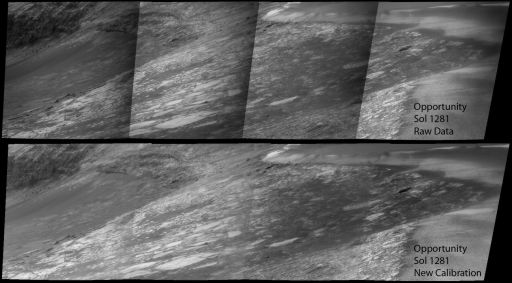 Doggone dust
Doggone dustThe panoramic cameras (Pancams) on Opportunity took on some dust during the storms that beseiged the rover in July. The top panel -- courtesy Jim Bell and colleagues at Cornell University -- shows four frames from a Sol 1281 (Sept. 1, 2007) Pancam panorama of the inner wall of Victoria Crater, near Duck Bay. These are raw images using the left eye 753 nanometer ("L2") filter. Notice the significant darkening of the right side of each image that causes large, ugly seams in the resulting mosaic. "We believe that that darkening is caused by dust that accumulated during the recent storm on and maybe in front of the Pancam's front sapphire window, which is recessed within a small sunshade on the front of each camera," Bell said. Luckily, the Pancam team's calibration pipeline is "flexible" they were able to acquire some new "flatfield" images recently to try to correct for this darkening. "Our latest result -- a work in progress -- is shown in the lower panel," Bell noted. "This is based on work primarily being done by Pancam software maven Jonathan Joseph here at Cornell. It's much improved, but we've still got a ways to go."Credit: NASA /JPL-Caltech / Cornell
Spirit From Gusev Crater
As August gave way to September, Spirit had returned to the "star" soil patch in the Silica Valley dubbed Gertude Weise, which the Mini-TES (Mini-TES) and alpha particle X-ray spectrometer (APXS) revealed was made of nearly pure silicon dioxide. The MER scientists wanted to get some new images and data of the target after the storm to help them characterize how much dust has accumulated on the instrument optics of the Mini-TES. While this instrument is located inside the boxy body of the rover below the mast, mirrors inside the mast allow the Mini-TES to see outside. Spirit has been using the spectrometer to measure changes in the atmosphere during the recent dust storm. When the rover isn't using the instrument, a cover protects it from dust floating in the atmosphere, but, alas, it isn't airtight and, not surprisingly some dust snuck onto the optics.
 Disturbed in the Silica Valley
Disturbed in the Silica ValleySpirit spent a little more time in the Silica Valley early this month, at Innocent Bystander, a high-silica rock it crumbled, and at Gertrude Weise, the soil patch target named after one of the star players for the All- American Girls Professional Baseball League, which turned out to be nearly pure silicon dioxide. Once its post duststorm investigation of this most intriguing target was finished, the rover finally drove up onto Home Plate.Credit: NASA / JPL - Caltech / Cornell
Spirit got back to its regular daily routine of measuring atmospheric opacity with the panoramic camera (Pancam) and surveying the sky and ground with the miniature thermal emission spectrometer (Mini-TES) this month and added checking for drift (changes with time) in the Mini-TES to the requisite agenda. The rover began the month by also taking some wide-range atmospheric dust measurements with the Pancam, then, after the evening pass of the Odyssey orbiter, recalibrated the dust measurements of the Pancam.
On Sol 1303 (September 2, 2007), Spirit spent much of its sol doing remotes sensing with its Mini-TES. First, it focuses the instrument at a specific area on the silicon dioxide soil patch, called Gertrude Weise14, then checked out the background of that target. It also used the instrument to home in on a soil target near Innocent Bystander called Innocent Bystander Disturbed Area 1, a target known as Mary Dailey3 and its background with the Mini-TES, and the target dubbed Joanne Winter2.
With the new measurements of Gertrude Weise and the other final targets in the Silica Valley, Spirit woke up the next sol, took some full color pictures of the disturbed soil area with the Pancam, then started its "engine," and drove 2.42 meters (7.94 feet) toward Home Plate. It took the usual images just before and after completing the drive with the hazard avoidance cameras, as well as post-drive images with the navigation cameras and Pancams. The rover attempted to "thread the needle" by driving between two rocks, however the maneuver was more difficult than anticipated. Spirit, of course, is still driving mostly backward, dragging its lame right front wheel.
On the first attempt, Spirit immediately stopped when its wheels entered an area designated as a keep-out zone as it was attempting to compensate for drag from the right front wheel by turning slightly in the opposite direction. Normally, the dragging wheel causes the rover to yaw counter-clockwise (if viewed from above), but the amount of counter-clockwise spin depends on the amount of drag encountered by the right front wheel. Rocky surfaces cause less drag than soil. In this case, the drag was less than anticipated.
The following day, Spirit's Sol 1305, the rover surveyed its external calibration target with the Mini-TES (Mini-TES) and took some movie frames in search of dust devils with its navigation camera, then recalibrated the Pancam as the crew on Earth reviewed the rover's data. After taking some full-color Pancam images of the disturbed soil area the next morning, the rover revved up and drove up the eastern edge of Home Plate with ease, completing an 8.21-meter (26.9-foot) drive. Finally -- after remaining beyond the margins of Home Plate since exiting its northeast edge way back on Sol 774 (March 7, 2006) to survive its second winter on Mars -- Spirit was back on top of the elevated, circular plateau that the MER scientists believe is volcanic in origin.
 Heading for Home
Heading for HomeSpirit finally roved up onto Home Plate this month to begin exploring the raised, circular plateau the way the MER scientists have been longing to do since they first saw the layered terrain. The team has been anxiously anticipating this expedition because the rover found salts left behind from salty water that evaporated, rocks that show evidence of being originally laid down wet, as well as signs of volcanic explosions where water contacted hot, molten rock -- the three primary ways of determining past water.Credit: NASA / JPL-Caltech
Spirit filled out the first week of the month by conducting a survey of rock clasts with the Pancam and listing files in its flash memory. Even rovers have to organize. In addition to its daily atmospheric research, the rover also looked at a soil target, called Beef Chili and a rock target known as Cajun Chili.
While the local features and targets around Home Plate have been named for deceased members of the All-American Girls Professional Baseball League, now that Spirit is on top of her target, the gameplan has changed. Since Home Plate is kind of bowl-shaped, Arvidson suggested naming features on top of the plateau after things served in bowls. [It was summer when he made the suggestion.]
The plan made for Spirit long ago still held and the rover began a transect, driving across the top of Home Plate to different, chosen stations along the way. The rover will use the instruments on its instrument deployment device (IDD) or robotic arm to document alteration trends from northwest to southeast across Home Plate and get a better look at vesicular basalts and potential Comanche-class rocks, named for rocks examined earlier in the mission while the rover was conquering Husband Hill.
At the top of the second week of September, Spirit examined targets called Gumbo, Goulash, Stew, and Pudding with the Mini-TES and the Pancam, then turned in place to characterize the drive toward its next work site. The rover began driving in that direction to determine how it would handle the terrain, taking images with the hazard avoidance cameras just before and after completing the drive, as well as post-drive images with the Pancam. The traction was good, so Spirit took off across the top of the elevated plateau and toward a fracture in the bedrock that the scientists saw in the images sent home and a destination point the team calls Station 2, where it would take the second part of a long-baseline, stereo view of Husband Hill and study the potential fracture, as well as collect some remote sensing data.
Spirit took it easy on Sol 1311 (September 10, 2007) spending most of its workday surveying the horizon with the Pancam in addition to its usual daily atmospheric tasks. On Sol 1312 (September 11, 2007), the rover monitored dust accumulation on its mast with the Pancam and continued driving, acquiring the usual before-and-after drive images with the hazard avoidance cameras, navigation cameras, and the Pancams. It also snapped a rearward-looking mosaic of navigation camera images.
During the next couple of science-packed sols, Spirit surveyed the horizon again, took full-color pictures of the fracture on Home Plate and some forward-looking images, acquired wide-range measurements of atmospheric dust with the Pancam and, as part of an ongoing study, measured atmospheric argon in the atmosphere with the alpha particle X-ray spectrometer (APXS). It also looked for the mineral content of targets dubbed Tapioca, Bouillabaisse, and Dumplings with the Mini-TES, took some Pancam images of Dumplings, completed another survey of rock clasts, finished taking the long-baseline stereo images of Husband Hill, and conducted some reconnaissance -- looking west, southwest, and south in search of potential drive paths and geological information.
On Sol 1315 (September 14, 2007), Spirit checked out a soil target known as Broth and rock targets known as Vichyssoise and Cioppino with the Mini-TES, then headed out toward Station 3, located at the southern end of Home Plate, about 30 to 40 meters (100 to 130 feet) away from Station 2, acquiring images along the way with the hazard avoidance cameras. After the drive, it took the usual images of the surroundings with the navigation and Pancams. The objective for the rover and the scientists at Station 3 is to get an elevated and better view of the southern part of Home Plate and Low Ridge, where the rover hunkered down to survive the last Martian winter. Later the same sol, after the rover completed the drive, Odyssey went into safe mode, so Spirit stayed put, mid-way to Station 3, and conducted remote sensing.
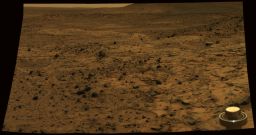 The view from Home Plate
The view from Home PlateSpirit took this mosaic from the top of Home Plate wqhen it first arrived at the formation on Sol 773 (March 6, 2006). The view spans about 70°. The dusty conditions on Mars over the last six week or so have given the Pancam team time to better process the image. The rover is scheduled to drive back onto Home Plate this weekend (September 1-2, 2007).Credit: NASA / JPL-Caltech / Cornell
Dust devils topped the agenda as Spirit roved into the third week of the month on Sol 1316 (September 15, 2007) and it reeled in 8 minutes worth of movie frames, as well as acquired a panel of navigation camera images looking to the rear of the fracture at Station 2 and a mosaic of Pancam images of the fracture.
After monitoring dust accumulation on its mast, taking some full-color images of the foreground, and completing another survey of rock clasts with the Pancam, Spirit scanned the foreground using both the navigation camera and Mini-TES, then recalibrated the Pancam's measurements of atmospheric opacity on Sol 1317 (September 16, 2007). On the following sol, the rover communicated directly with Earth through its high-gain antenna, enabling the operations team to confirm that the rover was still healthy and had successfully completed the Sol 1315 drive while Spirit spent the sol taking took thumbnail images of the sky with the Pancam, checking the external calibration target with the Mini-TES, and conducting its regular atmospheric research.
On Sol 1319 (September 19, 2007), Spirit spent most of the sol taking measurements of atmospheric dust, but did take some more movie frames in search of dust devils with the navigation camera. The Odyssey orbiter, meanwhile, resumed operations and relayed data from Spirit via the usual UHF radio transmissions, clearing the way for the rover to continue driving to Station 3.
After taking thumbnail images of the sky with the Pancam and monitoring dust accumulation on the mast with the Mini-TES on Sol 1320 (September 20, 2007), Spirit took off and on Sol 1323 (September 23, 2007) set "a new record for 5-wheeled rover on Mars" -- Callas said -- driving 19 meters across Home Plate to get to Station 3, its current location.
The driving on Home Plate "has been absolutely spectacular," enthused Squyres. "It's a combination of the fact that the top of Home Plate is a good Place to drive, significantly better than we were anticipating, and the rover planners are just getting really, really good at driving this rover in this terrain." Added Arvidson: "We allocated a number of sols to get from the entry point to Station 3 and we made it much faster than anybody thought we would."
"That gives me considerable hope for the future," said Squyres. "But hope is not a strategy. We have to have a carefully thought-out strategy for many things that could wrong. Recent performance on the vehicle has been absolutely outstanding, but we just cannot count on the driving continuing to be this good."
 Spirit's digs
Spirit's digsDuring its second Martian winter, Spirit sojourned in Low Ridge, its winter haven, from late April 2006 into December 2006, parked on a north-facing slope in order to keep its solar panels pointed toward the Sun. During that time, while the rover spent the daylight hours conducting as much scientific research as possible, science team members assigned informal names to rock outcrops, boulders, and patches of soil commemorating exploration sites in Antarctica and the southernmost islands of South America. Antarctic bases are places where researchers, like the rovers on Mars, hunker down for the winter in subzero temperatures. During the past Martian winter, Spirit endured temperatures lower than -100 degrees Celsius (-148 degrees Fahrenheit. This full-color mosaic of images -- taken from the mission's largest panorama,the McMurdo pan -- was acquired by the rover's PanCam. It shows the various features of the landscape at Low Ridge and the informal names used to identify them. In recent weeks, Spirit hit the road and this month arrived back at Home Plate.Credit: NASA/JPL-Caltech/Cornell
Concern about the oncoming Martian winter and Spirit's need to get to a 10-degree slope where it can pitch its solar arrays to take in as much sunlight as possible is ever-present. "In less than 200 sols, we have to be sitting on a pretty northerly facing surface to get ready for our second winter campaign site [third Martian winter]," said Arvidson. "So we're really designing the experiments and the locations to make sure that we have enough margin to get to a north-facing slope that is scientifically interesting."
This past week, Spirit has been checking out an outcrop target called Texas Chili, looking at the mineral content with the APXS, brushing it with the rock abrasion tool (RAT), then reexamining it with the APXS, the Mössbauer spectrometer, and MI. The scientists expect to be finished with that as the first day of October falls.
"This is an exciting period of time," said Arvidson. "We are on the southeastern portion of Home Plate, making some measurements of some of the outcrop. In the coming week, the plan is to drive to Station 4 on the southwestern side of Home Plate, where we can see to the south and into the valley that includes the little mesa or hill called von Braun, about 120 meters to the south of Home Plate proper." At Station 4, the MER team will have the rover look very carefully at that valley and see if it's traversable.
With two Martian winters under their rovers' rocker bogies, the MER team is thinking well ahead and already debating potential winter havens, Arvidson said. "We've identified several candidate locations where we can spend the winter," added Squyres. Right now, the scientists' sites are set on wintering in the von Braun-Goddard area.
While von Braun is kind of a mesa, Goddard is "more of a pit," said Squyres, "but they both have significant north-facing slopes on their northern sides. They're fantastic, fascinating, new and different science targets, so we'll be able to really spend a productive winter there." These formations are, however, far away. "We'll have to drive aggressively," he noted. Even so, the team is going to be identifying several, potential "bailout" locations along the way. "In addition to the major topographical features like von Braun and Goddard, there are also smaller, little bumps," Squyres pointed out. "Low Ridge was a small, local topographic feature that offered us the opportunity to scoot up onto a north-facing slope that was just steep enough to ride out the winter. There are a number of such little slopes between our location and von Braun and Goddard. If winter starts to come down on us faster than we can handle it, we want to have a place, an exit ramp that we can take to a safe haven between here and there."
All that plotted out, the current hope, said Squyres, "is that we will finish up at Home Plate and move in a sprightly fashion to the von Braun-Goddard regions with the intention of somewhere in there being our winter over spot."
Opportunity from Meridiani Planum
As September set in at Meridiani Planum, the skies were continuing to clear as dust fell from both the sky and Opportunity. After assessing the accumulation on the instruments and evaluating the payload, the MER team commanded the rover to begin a campaign to recalibrate the panoramic camera (Pancam) tau observations. These observations are what the team uses to measure the level of atmospheric opacity or how dusty it is. Fortunately, the solar array energy began to improve as the skies began to clear, increasing around the first of September to 350 watt-hours, giving the vehicle enough power to get back to its geologic field work.
 Victoria in 3-D
Victoria in 3-DOpportunity used its navigation camera on Sol 1278 (Aug. 28, 2007) to take the images combined into this stereo view. The rover was perched at the rim of Victoria Crater, which is about 800 meters (one-half mile) in diameter. After assessing possible routes for it to take into the crater, the MER team selected a site farther to the right along the rim, near the ripple of bright soil visible just outside the crater near the top center of this scene. This view appears in 3-D when viewed through blue-red glasses.Credit: NASA / JPL - Caltech
Opportunity arrived back at Duck Bay and the rim of Victoria Crater in late August, where it spent a week or so reexamining entry routes and re-imaging Duck Bay, as well as snapping images of other targets, including a rock dubbed Mango. Once the rover engineers at JPL had a chance to view the new, post-storm data and images, they decided to direct the rover to another point at Duck Bay about 130 feet away. The rocky surface there would provide "good traction and control of its path into the crater," according to rover driver Paolo Bellutta, and that would provide better access to the bright band of rocks about 40 feet from the rim.
Before sending it into the crater, the team had the rover conduct checkouts of several of its instruments -- the alpha particle X-ray spectrometer (APXS), the microscopic imager (MI), and the Pancams. As it turned out, the MI is in "good shape, with only minor contamination on its optics," reported Callas, "and we don't see any significant dust problem on the APXS." By comparison, the Pancams suffered from considerable dust contamination during the recent storm that is resulting in some blotching and dark edges in the images.
The Pancam team is working to characterize and correct for this, Jim Bell, the instrument's principal investigator, said in an interview yesterday. " It's especially noticeable when trying to mosaic images, which now appear to have noticeable seams in them because of the dust that is on the front sapphire windows of both Pancam cameras on Opportunity," he added. "We've taken some new calibration ("flatfield") data and we're working on devising a correction using the new calibrations, but we're not there just yet -- partly because some of that calibration data is still on the rover" [as a result of Odyssey falling into safe mode September 14].
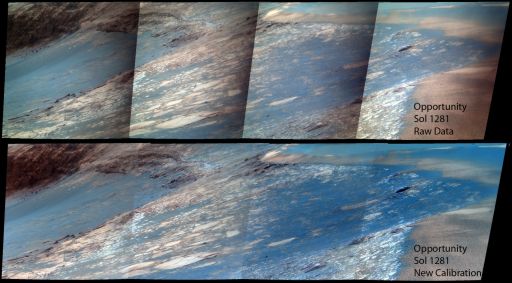 Doggone dust in false color
Doggone dust in false colorThe panoramic cameras (Pancams) on Opportunity took on some dust during the storms that beseiged the rover in July, which can be seen in these panels of false color images courtesy of Jim Bell and colleagues at Cornell University. The top panel -- as in the black and white panels pictured earlier in the story -- shows four frames from a Sol 1281 (Sep. 1, 2007) Pancam panorama of the inner wall of Victoria Crater, near Duck Bay.This too is a work in progress , Bell noted. Credit: NASA /JPL-Caltech / Cornell
[Editor's note: Bell said he was hoping they could figure out a way to use these calibrated images to generate the JPEGs that go out to the public every day, so that those who are working to make their own mosaics or are otherwise working with the images on their own don't have to completely re-invent this wheel. Stay tuned for that.]
Then there is the perplexing issue with the miniature thermal-emission spectrometer (Mini-TES) not getting good science data. "We still see a spectra that suggests a black body target and not the surface or atmosphere of Mars," Callas said. "We thought it was taking a picture of the cover, but we have checked that out and that is not the case."The team had Opportunity use its microscopic imager (MI) to look at the aperture as it tried to open the Mini-TES to see whether the instrument's scanning mirror, which is high on the rover's camera mast, was functioning accurately. [The mirror reflects infrared light from the landscape to the spectrometer at the base of the mast, and it also can be positioned to close the hole in the mast as protection from dust.] "We used the MI and did observe that it is operating properly, so we're scratching our heads as to what's going on," he said.
"I was really expecting that we were going to see that the [aperture] was not moving, that we had some kind of mechanical failure," added Squyres. "In fact, we have validated that everything is working right, yet the data still looks funny. Because of the fact that this problem arose during a significant dust storm when we know lots of dust is moving around – we saw a fair amount of dust buildup on the optics of Pancam – we now suspect this is a consequence of some dust getting somewhere into the system. We’re in the process of assessing that," he added. Whether or not this is a correctable problem or not is unknown at this point. "We have had good experience in the past with surfaces getting dusty and then getting cleaned again because of the wind," said Squyres. "But how much dust there is, where it is, and whether or not it truly is dust are all things that are not verified at this point. We're working the problem."
Given that the Mini-TES was only "guaranteed" to work for four months in the ever-changing thermal conditions on Mars, it's any wonder the instrument is still working at all. If the team cannot get the Mini-TES functioning again, it will be the first instrument loss on the mission. Whatever happens, the Mini-TES has made invaluable contributions to Opportunity's research at Meridiani. "Mini-TES has told us a lot about the rocks and soils at Meridiani, but we've learned that the differences among Meridiani rocks are often too subtle for it to distinguish," Squyres said.
To the mission's good fortune, it's not as big of a loss as it might have been. The Mini-TES on Spirit, which is still working, has "a much more crucial role" to play right now, because "there is such diversity at Gusev," he pointed out. For now, the scientists will now rely heavily on Opportunity's APXS for analysis of rocks at the bright-band target layer in the crater.
Opportunity completed the planned instrument checkouts on Sols 1288-1289 (September 8-9, 2007), so the RPs sent commands instructing it to take its "toe-dip" into Victoria Crater on Sol 1291 (September 11, 2007). This maneuver allowed the team to check wheel slippage and how the rover tracked the terrain. Once inside, the rover radioed home information via a relay with Odyssey, showing the team it had driven far enough in -- about 4 meters (13 feet) -- to get all six wheels inside the crater rim. It then backed uphill, as planned, but stopped after about 3 meters (10 feet). The driving commands for the day included a precaution for the rover to stop driving if its wheels were slipping more than 40 percent. When slippage exceeded that amount on the last step of the drive, Opportunity stopped, just like it was supposed to, with its front pair of wheels still inside the crater.
On Sol 1293 (September 13, 2007), Opportunity finished the last step of its in-and-out maneuver, pulling its front two wheels back out over the rim. "We want to maintain a safe egress route out of the crater for Opportunity, and by completing the back-up drive over the sand ripple at the rim, we have confirmed that we have one," noted Callas. The rover then immediately drove back into the crater for about 6 meters (20 feet) towards its first destination inside the crater, the light-toned layer of exposed bedrock that encircles the formation heading for a particular spot where the band of bedrock is exposed.
Since Victoria exposes a taller stack of ancient rock layers than any crater Opportunity has previously visited during the rover's nearly 44 months on Mars, this light-toned layer may preserve evidence of interaction between the Martian atmosphere and surface from millions of years ago -- and that's what the MER scientists are hoping to find.
On the following sol, 1294 (September 14, 2007), Odyssey went into safe mode where it stayed for the third week of the month, limiting the amount of data either rover could store onboard. Nevertheless, Opportunity continued with its daily, requisite atmospheric work and it did advance closer to its target. On Sol 1298 (September 18, 2007), it drove 7.45 meters (24 feet) toward the bright band and then, once Odyssey was back online, another 2.47 meters (8 feet) on Sol 1302 (September 22, 2007).
Since the drives put the rover at a 25-degree tilt, Opportunity was commanded to carry out safety checks, which showed that its wheel slippage was an acceptable 10 percent. So, on Sol 1305 (September 25, 2007) the rover continued on another 2.25 meters (7.38 feet) to where the chosen slab light-toned rock was within reach of its instrument deployment device (IDD) or robotic arm, according to information received from Mars late Tuesday. "We're facing straight across the slope so the rover is rolled 25 degrees, which is a difficult perch to be in but we're handling it well so far," said Squyres.
Opportunity is slated to begin IDD work on the bright band soon. "This will be the first of several stops within this band of rock," Squyres said. "We've been talking about the bright band, but there are actually three distinct layers in it, so we're starting at the top and working our way down. Our plan is to thoroughly work over each of the three layers with the IDD. By sampling it at several different levels in the crater, we're hoping to figure out the processes that led to its formation and its very distinctive appearance."
The MER team, Squyres said, has decided to name the layers after famous, influential sedimentologists and stratigraphers. The first layer -- where the rover will soon begin work -- is Steno -- after Nicholas Steno. "He is in many respects the father of sedimentology and stratigraphy, the guy who first articulated Steno's Principle -- that is, in a stack of rock the oldest ones lie at the bottom and the youngest ones lie at the top so you can actually do chronology by looking at layered rocks," informed Squyres.
Although Opportunity has been doing IDD work for more than three and a half Earth years, nearly two Mars years, the team plans to conduct this work carefully and take its sweet, appropriately calculated time. "IDD work on flat ground is one thing and on a 25-degree slope is another entirely," noted Squyres. "For example, some of the things we do with the IDD, like using the RAT, involve pushing down on the ground and if you're perched on slope like that, then pushing down can potentially be a risky thing because it might cause the wheels to shift. That could be a dangerous situation to get into."
"It's a challenging space because the rover is rolled at about 25 degrees right now, which is the limit of where we wanted to be," Callas agreed. "But we're doing some tests to make sure it's safe to use the IDD at these very high rolls, and we expect to be proceeding with in situ measurements in coming days."
Plans right now call Opportunity to be at this site for a number of weeks. Because of Opportunity's tilted position, the plans call for the ground to be in the loop on things where normally it wouldn't be, which takes time. In addition, the RAT, which suffered a failure in the encoder on the grind motor, can be used with the workaround that JPL and Honeybee devised but it takes longer to use the instrument. "We used to be able to brush and RAT a spot in one sol and now it takes two," said Squyres. "We want also to do good Mössbauer measurements on this and our Mössbauer spectrometer radiation source has gotten quite weak, so it will take days to get good readings," he added.
"We have invested so much time and so much effort in getting to this place and there is such interesting science at stake here that we're going to take our time and do it right," Squyres explained. "I suspect that we will be working in our current vicinity, within 5 meters of where we now sit, for quite a few weeks as we investigate these three layers, do the RAT grinding on each, take careful measurements with all of the instruments. It's going to take a while -- and it's going to be a lot of fun."
School has started again and even though the rovers are a full-time job even for those who have "day jobs," no one on this team is complaining. Spirit is, at long last Home and Opportunity is exploring Victoria Crater. "It has been a long time in coming," said Callas. "We're excited."
For all the MER Updates, go to: http://www.planetary.org/explore/space-topics/space-missions/mer-updates/
Support our core enterprises
Your support powers our mission to explore worlds, find life, and defend Earth. You make all the difference when you make a gift. Give today!
Donate

 Explore Worlds
Explore Worlds Find Life
Find Life Defend Earth
Defend Earth


